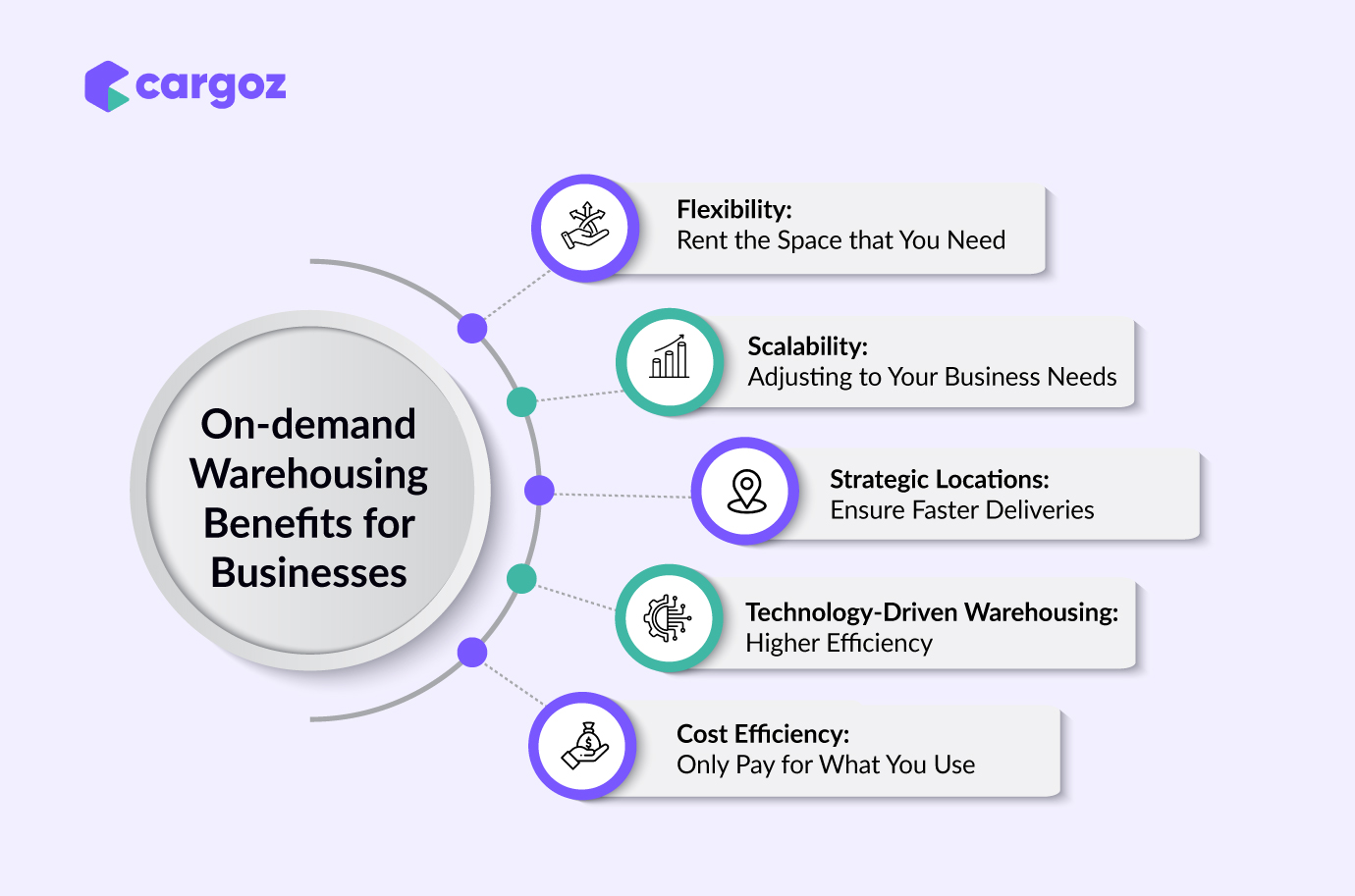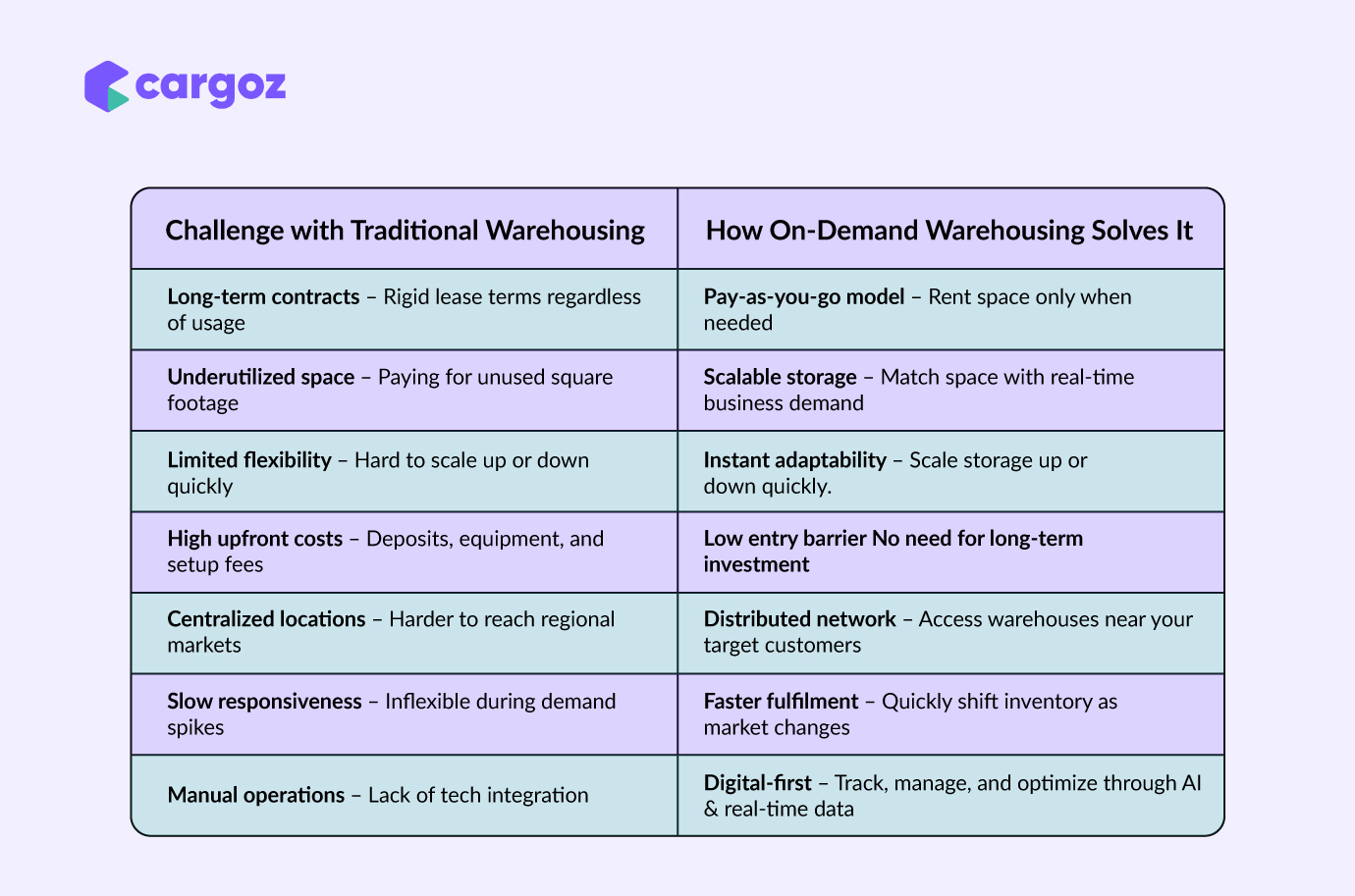Long-term leases, rigid contracts, and fixed space — these are some of the issues businesses face with the traditional warehousing model. But today's competitive business environment demands flexible storage facilities that allow you to increase or decrease space without a long-term commitment.
Is there a warehousing model that addresses these problems? The answer is “Yes”. With on-demand warehousing, you can enjoy the flexibility to change your space requirement, and the best thing is that you are not bound by any contract.
Due to this, most businesses are shifting towards this warehousing model. According to Grand View Research, the global on-demand warehousing market was around $114.93 billion in 2023 and is projected to grow at a CAGR of 13.3% between 2024 and 2030. In this blog, we will explore what is on-demand warehousing, its use case and how this warehousing model is transforming businesses.
Table of Contents |
|
What is On-demand Warehousing?
Simply put, on-demand warehousing is a flexible and cost-effective storage solution that allows businesses to rent storage space according to their business demands. You might have heard of the pay-as-you-go model for various services. On-demand warehousing is just like that for warehousing. You don't need to pay a hefty upfront amount, and you are not bound by a long-term obligation.
What Makes On-Demand Warehousing a Game-Changer for Businesses?
On-demand warehousing transforms how businesses rent storage spaces by offering customizable storage solutions. Let's look at the key factors that make an on-demand warehouse a game changer for today's businesses

Flexibility: Rent the Space that You Need
Imagine you need to store 100 tons of rice, but the minimum capacity of the available warehouses is 300 tons. So, you rent the entire warehouse but use only one-third of it, wasting both money and resources. This is exactly what happens with an inflexible warehousing model.
On-demand warehousing addresses these problems and allows you to rent only the space you need. Whether you need 50 square feet or 5000 square feet, you can choose the space your business requires and pay only for that.
Scalability: Adjusting to Your Business Needs
Whether you are launching a new product or experiencing a surge in orders, you may need additional space. On-demand warehousing allows you to scale your storage space in real time.
Not only that, when volumes drop during the off-season, you can reduce space without a penalty. For example, if you are in an ecommerce business, you need to ramp up storage during the holiday season, and an on-demand warehouse offers this benefit.
Strategic Locations: Ensure Faster Deliveries
Did you know that the global same-day delivery market was USD 10.1 billion and is expected to reach USD 66.8 billion by 2033? This shows that customers are increasingly looking for same-day delivery. If you are in a D2C business, you need warehouses at strategic locations instead of renting a large warehouse in a particular place.
By leveraging a network of on-demand warehouses, you can keep your inventory closer to your customers and ensure quick delivery. It will boost customer satisfaction and improve your brand's reputation.
Suggested Read: Why is location an important factor when choosing a warehouse
Technology-Driven Warehousing: Higher Efficiency
Real-time visibility of stock is essential for every business. If you can't track your stock, it will lead to business disruption and poor decision-making. On-demand warehousing leverages advanced technologies like warehouse management system, bar coding, etc. that help in real-time tracking, reporting and automation. These tools empower businesses in seamless warehouse operations, and make data-driven decisions.
Cost Efficiency: Only Pay for What You Use
If you rent a warehouse regularly, you must have observed that the standard warehousing model has unavoidable costs like long-term leases, unused space and maintenance charges. You must be looking to cut down these additional expenses, right?
On-demand warehousing helps you avoid these problems with a transparent, usage-based pricing model. You pay only for the space and duration you need. It reduces cost, improves your margin and frees up capital for other priorities.
The Problems with Traditional Storage Models
Conventional warehousing has several limitations that do not meet modern businesses' demands. Here are the key challenges businesses face with traditional storage solutions.
Fixed Space Commitments and Underutilization
With standard warehousing, you need to rent an entire warehouse even if you don't need the whole space. This means a lot of space remains unutilized, yet you must pay for it, significantly affecting your profit margin. Besides that, long-term leases or commitments make it difficult to exit even if you have to bear losses.
High Overhead Costs
Did you ever feel like your warehouse costs more than it is worth? This is common with conventional warehousing. High utility bills, insurance coverage, and constant facility maintenance add to the overhead costs. If your business is looking for a more flexible storage solution, the old-school warehouse model is not a wise move these days.
Inability to Adjust to Seasonal Demands
Fixed warehouse space and long-term contracts make increasing and decreasing space difficult during peak and off seasons. During high-demand periods, there may not be enough room to handle increased stock, while during the off season, a lot of space remains unused even though you keep paying for it. Without flexible storage options, businesses can't respond to evolving market demands, leading to inefficiencies and higher costs.
Suggested Read: The Impact of Seasonal Demand Cycles on Food-grade Warehouses
How On-Demand Warehousing Solves Current Storage Challenges

Use Cases Where On-Demand Warehousing Beats Standard Models
Seasonal Retail and eCommerce Demand
Think of times like Ramadan, Christmas, New Year, or other festival seasons. Sudden spikes in order volume are common during these seasons, and most businesses cannot handle them due to rigid warehouse leases.
On-demand warehousing allows retailers to quickly ramp up storage capacity for a few weeks or months and scale it down once the season ends. This ensures they don't lose sales due to limited inventory or overpay for unused space.
D2C Brands Expanding Across Regions
Direct-to-Consumer (D2C) brands looking to reach new markets quickly without investing in permanent infrastructure need a flexible storage solution. With on-demand warehousing, they can enter new markets without high overhead and store products near regional customer bases to reduce shipping times and improve customer satisfaction.
Exporters & Importers Managing Fluctuating Shipments
Businesses that export and import goods face variable shipment volumes due to market demands, supply chain delays, customs clearance, and other reasons. On-demand warehousing offers a flexible option to hold larger volumes of goods when needed.
Suggested Read: 7 Supply Chain Challenges Solved by On-Demand Warehousing
How to Find an On-Demand Warehouse in the UAE?
On-demand warehouses offer many benefits but finding the right provider is a challenge, especially in a dynamic market like the UAE. You need a platform that offers flexibility and connects you with reliable, verified storage options.
This is where warehouse marketplace like Cargoz can help. Cargoz lists verified storage facilities in Dubai and across the UAE. With Cargoz, you can find on-demand warehousing options in all sizes to meet your needs. There are no long-term contracts, no wasted space, you pay for what you use.
Is On-Demand Storage the Future of Warehousing Trends?
The short answer is "Yes."
Today's businesses want adaptability, cost efficiency, and quick storage solutions. The rigid storage model offers fixed space and is bounded by long-term contracts, making it difficult for businesses with evolving needs.
On-demand warehousing, on the other hand, offers scalable, location-flexible solutions that match how modern businesses operate.
It allows companies to:
- Tap into storage space where and when they need it
- Reduce long-term overhead
- Stay responsive to seasonal or regional shifts in demand
- Leverage digital warehousing powered by AI, IoT, and real-time analytics
A GlobalTrade report reveals that 60% of businesses have already adopted on-demand warehousing or are considering it. This shows how quickly the industry is shifting in this direction.
Conclusion
On-demand warehousing is not only about cost-saving but also a strategic shift towards a smarter and more efficient storage solution. As a result, more businesses are shifting away from traditional storage contracts to flexible, on-demand warehouses.
If you are looking for a simpler way to find and rent storage space in Dubai and across the UAE, Cargoz can help. As a trusted warehouse marketplace, Cargoz allows you to explore a wide network of verified warehouses that offer on-demand storage. Contact us and we will help you find the perfect warehouse for your business.
